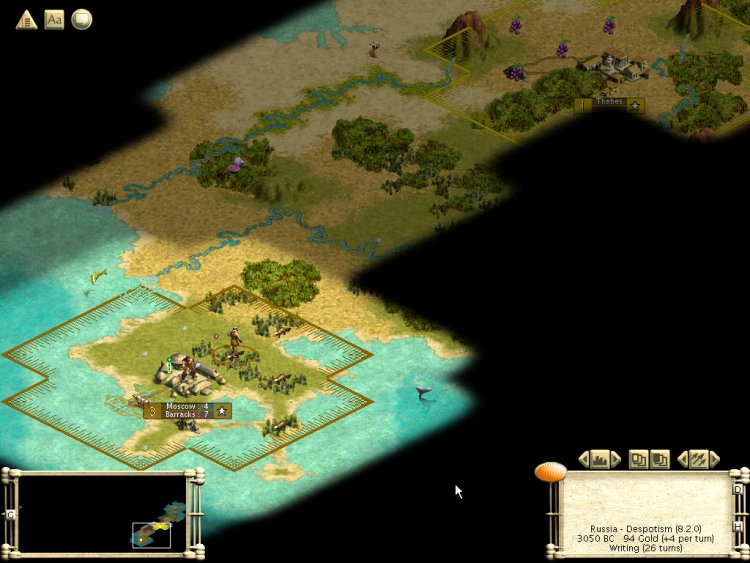*waves* hi Jamie.

Yes, actually the ability to irrigate the cow is huge. Do you know the tile bonuses and how the despotism penalty works? Knowing that sort of thing is vital to making a settler factory work. Ignoring commerce for now, and assuming we do settle one tile southwest on the non-bonus grass, we'll have the following tiles to work with:
One cow on grassland -- unimproved, this gives three food and one shield per turn in despotism. Since two of those food are needed to feed the citizen who works the tile, this amounts to one extra food and one shield per turn. Irrigation would add one more food per turn; mining would give one more shield.
Three fur forests over grassland -- unimproved, these are nothing special. They yield only one food per turn (-1 fpt net) and two shields. The fur gives a bonus shield, but that is lost to the despotism penalty. With the forests cut down and mines built, though, these tiles are powerhouses: +2 food per turn (0 net) and +2 shields per turn.
Three bonus grasslands -- when mined, 0 net food and +2 shields per turn (same as mined fur grasslands).
There's no point in irrigating either of the above two tile types during despotism unless we have to bring irrigation to dry plains or something; the extra food from irrigation is lost to the despotism penalty.
We have one lake tile we can use if we're going to have a shield overrun: it produces 0 net food and no shields, but gives extra commerce compared to the regular bonus grass tiles we'll have.
There's also the city tile itself, which produces +2 net food and +1 shield every turn no matter what.
As for the settler factory, towns of size six or less with granaries need ten "extra" (net) food to grow. A town needs to grow twice to produce a settler without net loss of population. The settler itself takes 30 shields to produce. So to make a settler factory work, you need your city to be able to produce twenty net food and 30 shields over a particular number of turns. It's probably easier to just show the numbers in this case than to describe it in words.
Here's how the six-turn archer/settler factory I described above would work.
Turn 1: Capital at size 4, no food or shields accumulated beyond the 10 reserve food in the granary. Set production to archer. Set citizens to working four mined bonus grasses or mined fur-on-grass tiles. Net food for the turn is +2 (city tile) + 0 + 0 + 0 + 0 (bonus grasses or equivalent) = +2 food. Production is +1+2+2+2+2 = 9 shields.
Turn 2: Switch one citizen to the irrigated cow square. Food increases to +4, shields down to 8.
Turn 3: Same as turn 2. Accumulated food after three turns is +10, and accumulated shields is 25.
Turn 4: Capital grows to size five, having filled its food box, and the archer is produced. Shields and food are back to zero (not counting the granary). The governor will have stuck the new citizen on any forest tiles we have remaining, so we'll need to reset things to once again be working all bonus grasses or equivalent. Set production to settler. Food on this turn is +2 net, production is 11 shields.
Turn 5: Move one citizen to the irrigated cow. Food +4, production 10 shields.
Turn 6: Same as turn 5. Food +4, 10 shields. Total for turns 4 through 6 is +10 food and 31 shields.
Turn seven produces the settler, and we're back to where we started on turn 1. Set to archer, citizens to bonus grasses, lather rinse repeat.
I've left a couple of details out that aren't necessary to the basic picture, but in essense, that's it. Irrigating the cow is essential -- without doing that, the most excess food we could get on any one turn is +3. It'd take four turns to grow at that rate, and therefore eight turns to build a settler without net population loss. This way is obviously faster.
The only thing I'm not 100% certain about is corruption. I don't know how many shields we can get to before we lose one. It may or may not affect the optimum size and production capacity of our settler factory.
Renata








![PTW Icon [ptw] [ptw]](/images/smilies/ptw.gif) is on!
is on!
